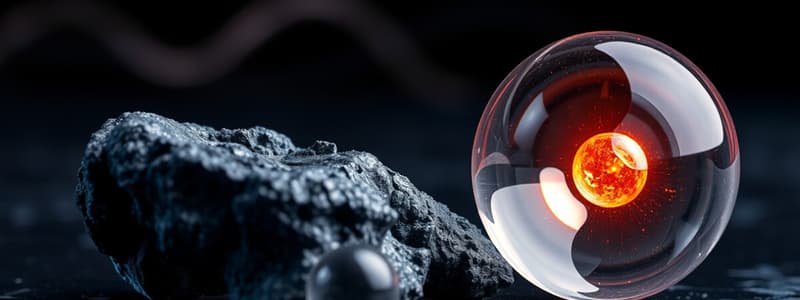Podcast
Questions and Answers
Which characteristic is NOT used to describe a solid?
Which characteristic is NOT used to describe a solid?
- Texture
- Flow (correct)
- Shape
- Color
What property do liquids and gases share?
What property do liquids and gases share?
- They can be seen.
- They take the shape of their container. (correct)
- They have a definite shape.
- They have a fixed volume.
Which of the following is true about solids?
Which of the following is true about solids?
- Solids can be measured for size. (correct)
- Solids flow freely.
- Solids have no definite mass.
- Solids take the shape of their container.
How can you describe a solid's texture?
How can you describe a solid's texture?
Which state of matter is described as having a definite shape?
Which state of matter is described as having a definite shape?
Which of the following statements correctly describes solids?
Which of the following statements correctly describes solids?
Which statement is true regarding liquids?
Which statement is true regarding liquids?
Which of the following describes gases?
Which of the following describes gases?
What must all matter possess?
What must all matter possess?
Which of the following properties is NOT typically associated with gases?
Which of the following properties is NOT typically associated with gases?
Flashcards are hidden until you start studying
Study Notes
States of Matter
- Matter exists in three primary states: solid, liquid, and gas.
- Matter is defined as anything that has weight and occupies space.
- Objects can differ in size, shape, color, and texture, which helps classify them.
Solid Characteristics
- Solids have a definite shape and volume.
- Descriptors for solids include shape (round, square, triangle), color, size (big, small, tall), and texture (rough, soft, hard).
- Measurement tools like rulers or meter sticks are used to determine the length and width of solids.
Liquid Characteristics
- Liquids can flow and take the shape of their containers.
- They maintain volume but have no definite shape.
- Liquids come in various colors and tastes (sweet, sour, bitter, salty) and may have pleasant or unpleasant odors.
Gas Characteristics
- Gases have no definite shape or volume and fill their containers.
- They are generally invisible but can be felt or smelled.
- Air is the most common example of gas in our environment.
Properties of Matter
- Solids can be identified by their ability to maintain shape and volume.
- Liquids can be characterized by their ability to flow and lack of definite shape.
- Gases spread out to fill available space and lack a fixed shape or volume.
Assessment Statements
- Solid has weight and occupies space (True).
- Liquid flows and takes the shape of the container (True).
- Gas is omnipresent, has weight, and occupies space (True).
- Liquid and gas have no weight but occupy space (False).
- Solid objects can be classified by various properties including shape, color, and texture (True).
Observations
- Encourage hands-on activities to explore and observe the characteristics of different states of matter.
- Look for objects around home and classify them based on their physical properties.
Studying That Suits You
Use AI to generate personalized quizzes and flashcards to suit your learning preferences.




